Violent squalls bring big gains and losses
leg 5 Day 12 - 14:55 GMT Wednesday, February 25, 2009. |
 |
| All five boats racing down the South Pacific Ocean in leg five of the Volvo Ocean Race are engaged in a battle with nature. The doldrums and the associated clouds and squalls are causing big gains and huge losses across the fleet as the boats get pushed further away from their optimum courses by the unstable weather. |
 |
Telefonica Blue in rough weather, on leg 5 of the Volvo Ocean Race, from Qingdao to Rio de Janeiro.
Photo © Gabriele Olivo / Telefonica Blue / Volvo Ocean Race.
|
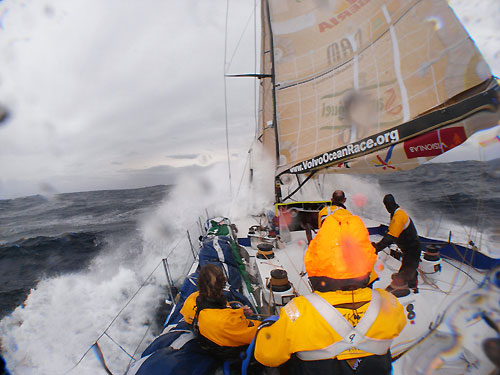 |
|
 |
"It’s all about your route through the cloud minefield," says Guy Salter from Ericsson 4 (Torben Grael / BRA) who is clinging onto first place.
"Often you just can’t avoid them [the clouds] and have to accept that several miles away, your competitor is having an easier time of it," Salter explained, as the team looks over its shoulder to see PUMA (Ken Read / USA) and Ericsson 3 (Magnus Olsson / SWE) 26 nm astern and gaining. |
 |
Rain onboard Ericsson 4 for Ryan Godfrey, in the Doldrums, on leg 5 of the Volvo Ocean Race.
Photo © Guy Salter / Ericsson 4 / Volvo Ocean Race.
|
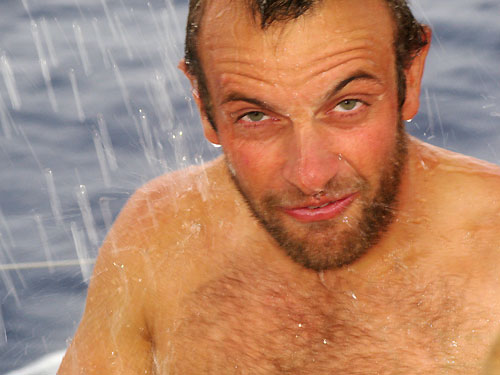 |
|
 |
According to Salter, the clouds have often left Ericsson 4 in a complete void without even a breath of wind, before suddenly sending down a squall with such speed that the team has often found itself a fair way off their optimal course, and has been pushed further south than they planned.
With clouds, come big gains and losses. Two days ago, Ericsson 3 (Magnus Olsson / SWE) sailed into PUMA’s world and has been their constant companion ever since. |
 |
Anders Dahlsjo, Martin Krite and Aksel Magdahl taking down the masthead code zero, on leg 5 of the Volvo Ocean Race, from Qingdao to Rio de Janeiro.
Photo © Gustav Morin / Ericsson 3 / Volvo Ocean Race.
|
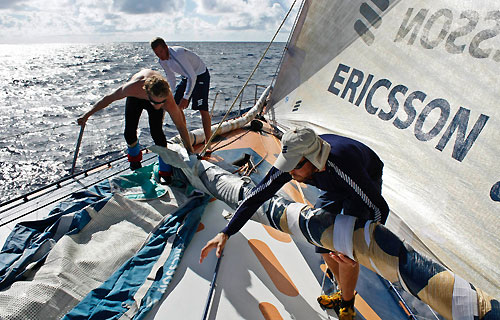 |
|
 |
"We then started a 48-hour flat out drag race and slowly pulled out a very hard-earned four-mile lead, only to have it evaporate late last night in one squall," explains PUMA’s skipper Kenny Read.
"We slowed to 11 knots, they came roaring up at 20 and it has been game on ever since," he said.
At 13:00 GMT today, PUMA had regained a marginal upper hand and is in second place. Both boats gybed onto a southerly course just after 09:30 GMT this morning and are split across a lateral divide of 6.5 nm west to east and making about five knots. |
 |
Crossing the equator onboard PUMA Ocean Racing, on leg 5 of the Volvo Ocean Race.
Photo © Rick Deppe / PUMA Ocean Racing / Volvo Ocean Race.
|
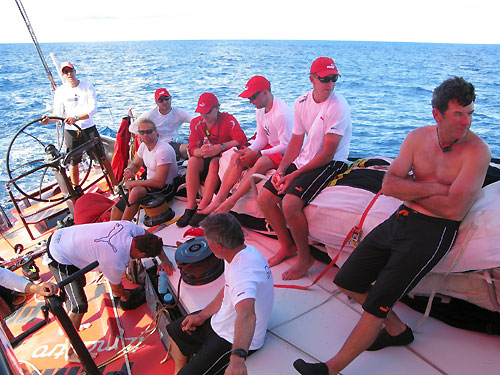 |
|
 |
The squalls in this region appear to be quite prevalent and can last up to two hours. The first signs of a vicious squall approaching is a general darkening of the sky and a thickening of the clouds to weather of the boat. The leading edge of the squall is accompanied by a high probability that there will be a significant wind shift.
Rick Deppe says that when they observe the high black cloud, light rain starts to fall which lasts for about five minutes. It is generally followed by a short pause in the rain, which may be accompanied by possible clearing of the clouds.
"The break will only be for a few minutes before the large drops start to fall from the puffy nimbus clouds that make up the body of the squall," he says. These conditions are likely to last for at least another three days as the fleet picks its way towards Fiji. |
 |
Ericsson 3 crew talk tactics at the navigation station, during leg 5 of the Volvo Ocean Race, from Qingdao to Rio de Janeiro.
Photo © Gustav Morin / Ericsson 3 / Volvo Ocean Race.
|
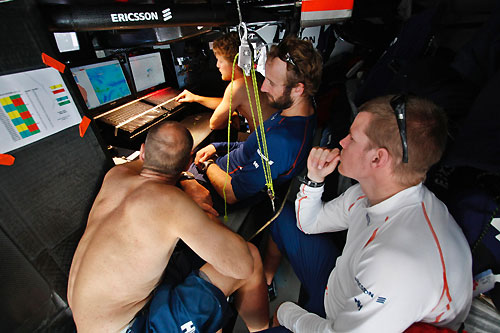 |
|
 |
"Once the call has been made that we are about to get hit [by a squall], the crew has to react quickly to make the boat safe - wind speeds in a squall can easily double or increase by 20 knots. The squalls generate a sloppy wave pattern and the boat starts to crash and bump because the waves are disorganised and random," explains Deppe.
Making the most of the conditions and very much back in the game is Ian Walker’s Green Dragon. The team is 86 nm to the east of Ericsson 4’s track and averaging a steady 13.5 knots. |
 |
Rough weather for Green Dragon, on leg 5 of the Volvo Ocean Race, from Qingdao to Rio de Janeiro.
Photo © Guo Chuan / Green Dragon Racing / Volvo Ocean Race.
|
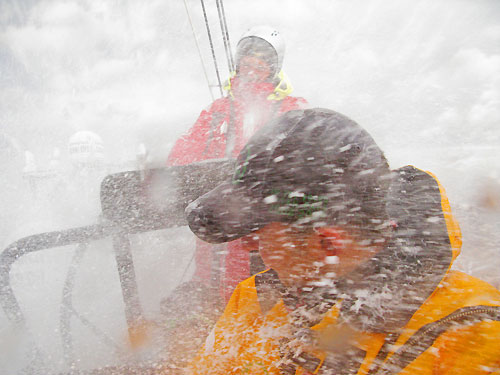 |
|
 |
"The fleet has opted to follow our easterly route, which has consolidated some very big gains for us," said Ian Walker who celebrates his 39th birthday today. "We have taken over 200 miles out of the leaders
and are very much back in the hunt. It looks like everyone is shaping up to go east of Fiji, where a large area of no wind awaits the fleet," he said.
Telefónica Blue (Bouwe Bekking / NED) is in fourth place, but closing quickly and averaging 10 knots of boatspeed. Bekking is still playing it conservatively, following the pack and not making any radical decisions. Their track takes them 84 nm west of the tracks of PUMA and Ericsson 3. |
 |
Simon Fisher trimming the main and Michael Pammenter driving, on leg 5 of the Volvo Ocean Race, from Qingdao to Rio de Janeiro.
Photo © Gabriele Olivo / Telefonica Blue / Volvo Ocean Race.
|
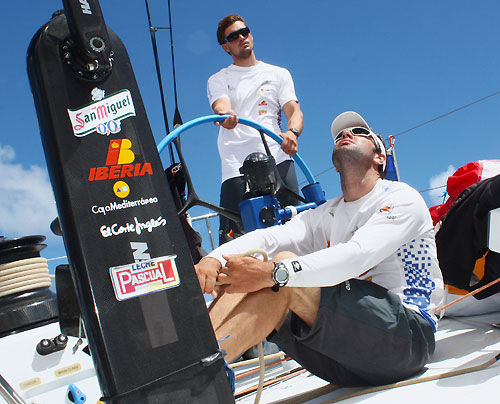 |
|
 |
"Our boatspeed over the last few days has been really good and we feel that if we can get into the same patch of water as the others in this light to moderate reaching, then we will do well," said navigator Tom Addis.
The team is happy to follow the leaders down to the first scoring gate at 36 degrees south, where they expect a restart with the fleet.
Although the fleet continues to battle with all that nature can throw their way, occasionally the wind Gods smile and clouds arrive at just the right time to give a real boost in the right direction.
"Breeze picking up now - 14 knots of boats speed and by the look of this cloud, it is lined up quite nicely for us and we should get quite a nice run out of it for 10 miles or so. Nice, friendly helpful, benevolent, thoughtful cloud..." wrote Tom Addis from Telefónica Blue at 07:05 GMT today. |
 |
Xabier Fernandez driving Telefonica Blue, at sunset, on leg 5 of the Volvo Ocean Race, from Qingdao to Rio de Janeiro.
Photo © Gabriele Olivo / Telefonica Blue / Volvo Ocean Race.
|
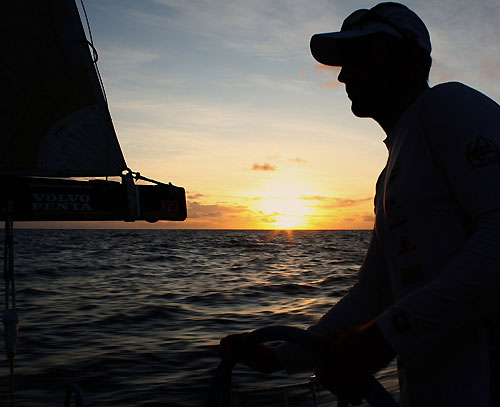 |
|
 |
Leg 5 Day 12 - 13:00 GMT Volvo Ocean Race Positions
(Boat name / country / skipper / nationality / distance to finish)
Ericsson 4 SWE (Torben Grael / BRA) DTF 8,830 nm
Ericsson 3 SWE (Magnus Olsson / SWE) +26
PUMA Racing Team USA (Ken Read / USA) +26
Telefónica Blue ESP (Bouwe Bekking / NED) +62
Green Dragon IRL / CHI (Ian Walker / GBR) +88
Delta Lloyd IRL (Roberto Bérmudez / ESP) DNS
Telefónica Black ESP (Fernando Echávarri / ESP) DNS
Team Russia RUS (Andreas Hanakamp / AUT) DNS
Visit www.volvooceanrace.org for all the latest news! |
|

